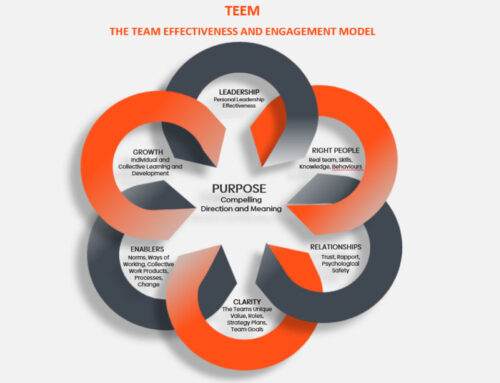
Leadership presence is a powerful quality that sets great leaders apart – evident in how they speak, act and carry themselves. Here’s how to recognise it, build it and lead with greater influence.
Once dismissed as corporate jargon, leadership presence has become a serious predictor of leadership potential. But ask ten leaders to define it, and you’ll likely get ten different answers. Is it charisma? Confidence? Command of the room? In reality, leadership presence is less about showmanship and more about substance – how you show up, how you hold space and how others experience you. It’s not a fixed trait, but a learnable skill, and mastering it can be the difference between moving forward or being overlooked.
Leadership presence isn’t about volume, bravado, or having the flashiest slides. It’s about how you engage, express, and connect. Let’s break this down into three core sets of traits:
- Personal qualities: Passion, poise, and self-confidence. These make people believe you belong in the room.
- Communication skills: Candour, clarity, and openness. It’s not just what you say, it’s how clearly and honestly you say it.
- Relational cues: Thoughtfulness, sincerity, and warmth. These determine whether people want to follow you, or tune you out.
Even what you wear counts. (Look up enclothed cognition – yes, it’s real.)
In short: leadership presence is what makes people listen when you speak, and trust you once they do.
The 80% You’re Probably Ignoring
Here’s the surprising truth: as much as 80% of communication happens without words.
You can have brilliant ideas and airtight arguments, but if your delivery is off – flat tone, weak eye contact, closed posture – your impact will fall flat too.
People don’t just hear what you’re saying. They feel how you’re saying it.
Seven Tools You Already Use but Might Not Be Using Well
The good news? You don’t need to reinvent yourself. You just need to sharpen tools you already use every day:
- Eyes – Direct gaze signals confidence. Shifty eyes? Not so much.
- Face – A smile, a frown, a furrowed brow. Your expressions speak before you do.
- Body – Open posture invites. Crossed arms repel.
- Voice – Monotone kills energy. Vary your tone to hold attention.
- Pace – Too fast sounds anxious. Too slow, and people check out.
- Message architecture – Organise your points with intention. Clarity = credibility.
- What are you wearing – how you show up visually matters – consider the sartorial choices you are making and the impact they are having on those around you – are you dressed for the occasion?
These are the instruments of presence. Use them well, and you lead without needing to declare it.
Presence Can’t be Faked
You can’t manufacture trust or fake warmth. Not for long. People are highly attuned to authenticity. Trying to perform presence instead of being present almost always backfires.
The goal isn’t to put on an act. It’s to align your natural self with stronger, more intentional expression.
Start Here With These Simple Ways to Build It
Want to start sharpening your presence? Here’s how:
- Record yourself – Watch yourself lead, present, or contribute in meetings.
- Review critically – Look for what you’re projecting – what’s working, what’s not.
- Pick your battles – Focus on two or three behaviours that will have the biggest impact.
- Get real feedback – Ask colleagues you trust to give it to you straight.
- Steal like a leader – See someone nailing it? Try their approach, adapt it to your style.
- Practice relentlessly – Improvement is a loop: test, tweak, repeat.
It’s Built, Not Born
Leadership presence isn’t some innate charisma you either have or don’t. It’s a set of habits, behaviours, and signals that you can learn and refine – just like any other leadership skill.
Work on your posture. Tune your voice. Sharpen your look. Shape your story.
ECI Partners
To connect with us about executive coaching please contact us here.


